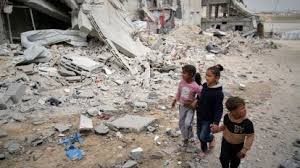Tragedy in Gaza: Israeli Strikes Kill 32, Most Victims Are Women and Children
In one of the deadliest attacks in recent weeks, Israeli airstrikes pounded parts of the Gaza Strip on Monday, killing at least 32 Palestinians. Most of the victims were women and children, according to local health officials and humanitarian groups operating in the area.
The airstrikes hit several areas across Gaza, including residential neighborhoods and areas near hospitals, triggering fresh waves of panic among families who have been trying to survive amid months of violence.
Scenes from the ground were heartbreaking. People dug through the rubble with bare hands, searching for loved ones. Ambulances and rescue crews struggled to reach some of the worst-hit areas due to ongoing strikes and damaged roads.
A Journalist Killed While Reporting Near Hospital Grounds
One of the most disturbing incidents took place just outside Nasser Hospital in Khan Younis. A media tent, set up for journalists covering the ongoing war, was struck in an air raid. Two people were killed instantly, including Yousef al-Faqawi, a local journalist known for his fearless reporting. Six others were wounded, among them freelance journalist Hassan Eslaiah, who Israel later alleged was connected to Hamas.

Targeting an area so close to a medical facility and a press zone has sparked outrage and renewed calls for accountability. Journalists have been essential in documenting the human toll of this conflict, often at great personal risk.
Families Under Fire: “We Don’t Know Where Is Safe Anymore”
Across Gaza, residents are living in constant fear. With shelters overcrowded and food supplies running dangerously low, families are desperate. “We don’t know where is safe anymore,” said Rana Abu Salim, a mother of three who lost her niece in one of the attacks. “Every night we hear the planes, and every morning we count who’s still alive.”
Hospitals are overwhelmed, running short on medicine, electricity, and even clean water. The World Food Programme announced it had to suspend food distribution in some areas due to security risks, worsening hunger and desperation among the 2 million people trapped in the enclave.
Calls Grow Louder for a Ceasefire
The latest wave of attacks has prompted renewed calls for a ceasefire from international organizations and human rights advocates. Several United Nations agencies released a joint statement urging both sides to halt the violence and protect civilians.
“The situation is spiraling. Children are dying. Hospitals are collapsing. Aid is being blocked. This is not just a humanitarian crisis—this is a catastrophe,” the statement read.
Over the past week alone, over 1,000 children have been killed or injured, making it one of the deadliest periods for Gaza’s youth in recent memory.
A Conflict That Shows No Signs of Ending
This recent escalation is part of the broader conflict that reignited in October 2023, when Hamas launched a surprise assault on Israel, killing and kidnapping hundreds. In response, Israel began a relentless military campaign aimed at dismantling Hamas, which has now continued for nearly a year and a half.
Since then, tens of thousands of Palestinians have been killed, according to Gaza’s Health Ministry. Entire neighborhoods have been flattened, and basic infrastructure is in ruins. The Israeli government says its operations are necessary for security, but critics argue that civilians are bearing the brunt of the cost.
Prime Minister Benjamin Netanyahu’s recent meeting with former U.S. President Donald Trump raised eyebrows after they discussed the controversial idea of “voluntary emigration” for Palestinians—something many view as forced displacement under another name.
A Region on the Brink
As the bombs continue to fall, ordinary people in Gaza are left to pick up the pieces. Parents bury their children. Children grow up in shelters, their only memories shaped by sirens and explosions. The grief is immense. The fear is constant.
Without an immediate ceasefire and a path toward peace, the bloodshed is likely to continue. For the people of Gaza, survival is no longer just about food or water—it’s about making it to tomorrow.


Comments are closed, but trackbacks and pingbacks are open.